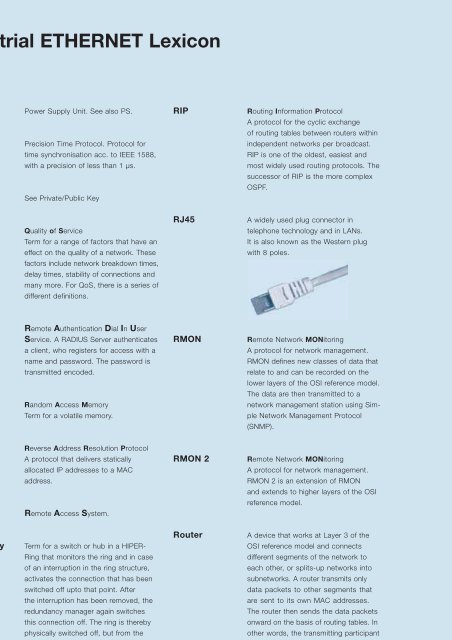Industrial ETHERNET
Industrial ETHERNET
Industrial ETHERNET
- No tags were found...
Create successful ePaper yourself
Turn your PDF publications into a flip-book with our unique Google optimized e-Paper software.
<strong>Industrial</strong> <strong>ETHERNET</strong> Lexicon<br />
PSU<br />
PTP<br />
Public Key<br />
Power Supply Unit. See also PS.<br />
Precision Time Protocol. Protocol for<br />
time synchronisation acc. to IEEE 1588,<br />
with a precision of less than 1 µs.<br />
See Private/Public Key<br />
RIP<br />
Routing Information Protocol<br />
A protocol for the cyclic exchange<br />
of routing tables between routers within<br />
independent networks per broadcast.<br />
RIP is one of the oldest, easiest and<br />
most widely used routing protocols. The<br />
successor of RIP is the more complex<br />
OSPF.<br />
QoS<br />
Quality of Service<br />
Term for a range of factors that have an<br />
effect on the quality of a network. These<br />
factors include network breakdown times,<br />
delay times, stability of connections and<br />
many more. For QoS, there is a series of<br />
different definitions.<br />
RJ45<br />
A widely used plug connector in<br />
telephone technology and in LANs.<br />
It is also known as the Western plug<br />
with 8 poles.<br />
RADIUS<br />
RAM<br />
Remote Authentication Dial In User<br />
Service. A RADIUS Server authenticates<br />
a client, who registers for access with a<br />
name and password. The password is<br />
transmitted encoded.<br />
Random Access Memory<br />
Term for a volatile memory.<br />
RMON<br />
Remote Network MONitoring<br />
A protocol for network management.<br />
RMON defines new classes of data that<br />
relate to and can be recorded on the<br />
lower layers of the OSI reference model.<br />
The data are then transmitted to a<br />
network management station using Simple<br />
Network Management Protocol<br />
(SNMP).<br />
RARP<br />
RAS<br />
Reverse Address Resolution Protocol<br />
A protocol that delivers statically<br />
allocated IP addresses to a MAC<br />
address.<br />
Remote Access System.<br />
RMON 2<br />
Remote Network MONitoring<br />
A protocol for network management.<br />
RMON 2 is an extension of RMON<br />
and extends to higher layers of the OSI<br />
reference model.<br />
Redundancy<br />
Manager<br />
RFC xxx<br />
Term for a switch or hub in a HIPER-<br />
Ring that monitors the ring and in case<br />
of an interruption in the ring structure,<br />
activates the connection that has been<br />
switched off upto that point. After<br />
the interruption has been removed, the<br />
redundancy manager again switches<br />
this connection off. The ring is thereby<br />
physically switched off, but from the<br />
point of view of communication, it is<br />
interrupted.<br />
Request for Comments<br />
An abbreviation that was coined<br />
within the context of the Internet.<br />
It is closely linked to the publication<br />
of Internet standard.<br />
Router<br />
Routing<br />
A device that works at Layer 3 of the<br />
OSI reference model and connects<br />
different segments of the network to<br />
each other, or splits-up networks into<br />
subnetworks. A router transmits only<br />
data packets to other segments that<br />
are sent to its own MAC addresses.<br />
The router then sends the data packets<br />
onward on the basis of routing tables. In<br />
other words, the transmitting participant<br />
must know that the receiver is not<br />
located in the same network segment.<br />
The transmitting station obtains this<br />
information from the IP address of the<br />
recipient. Routing tables are either given<br />
as fixed tables or are given by the router<br />
itself using routing protocols.<br />
A function of Layer 3 of the OSI reference<br />
model. A distinction is made between<br />
dynamic and static routing. In dynamic<br />
276











